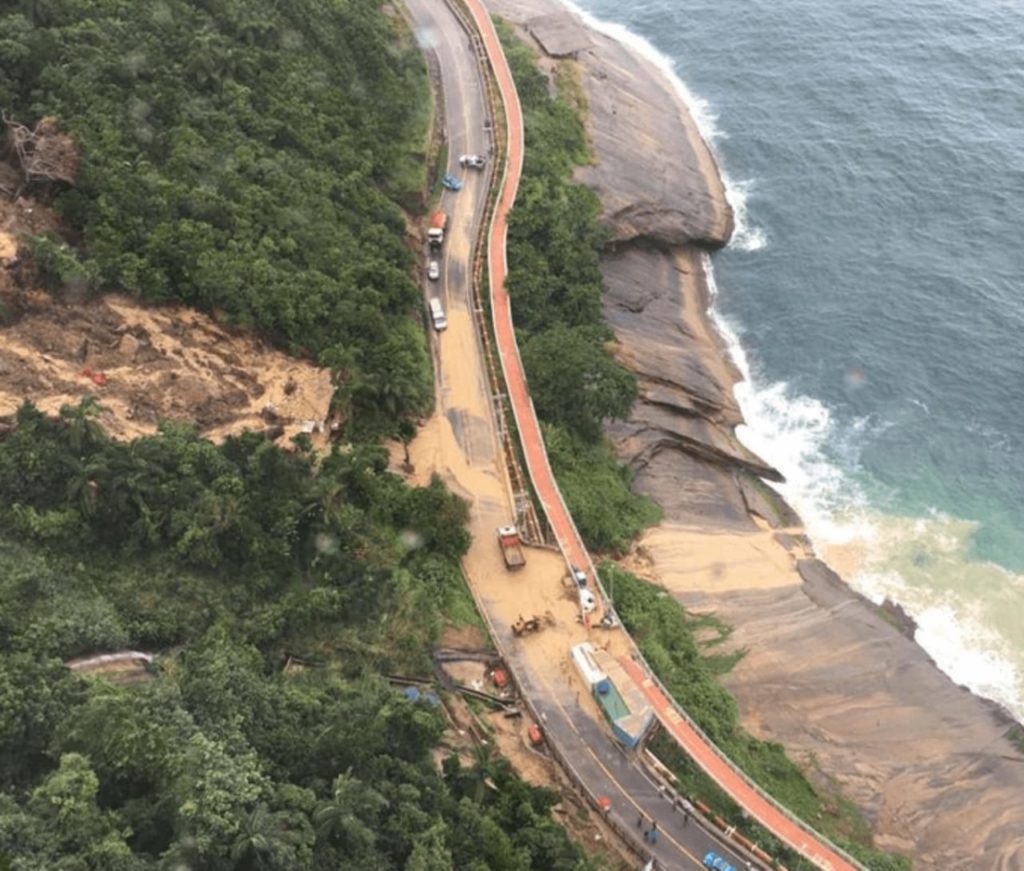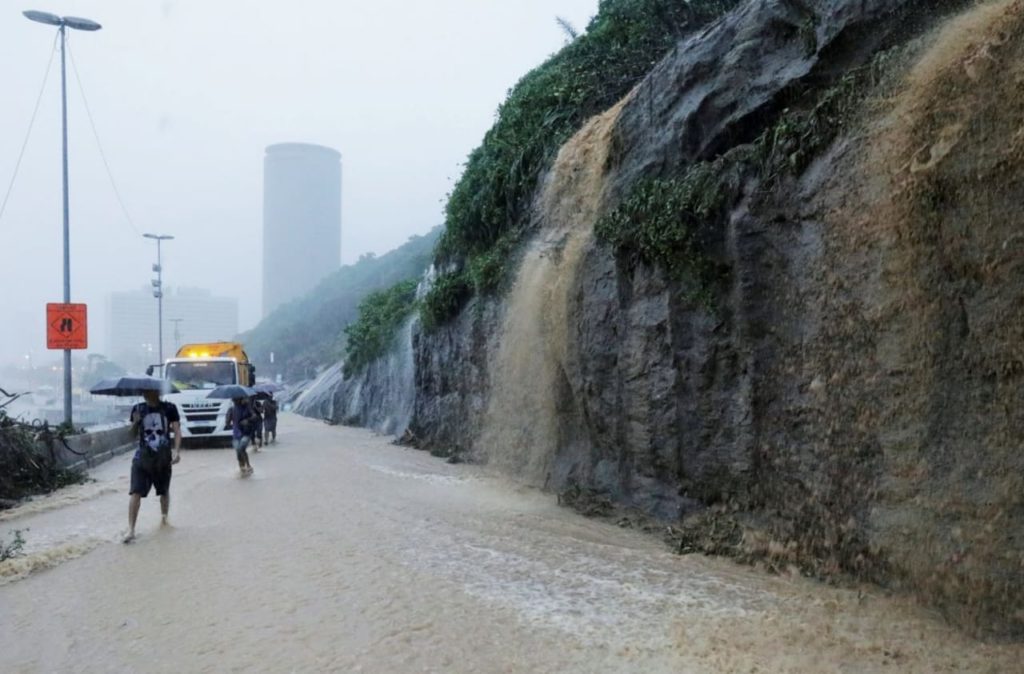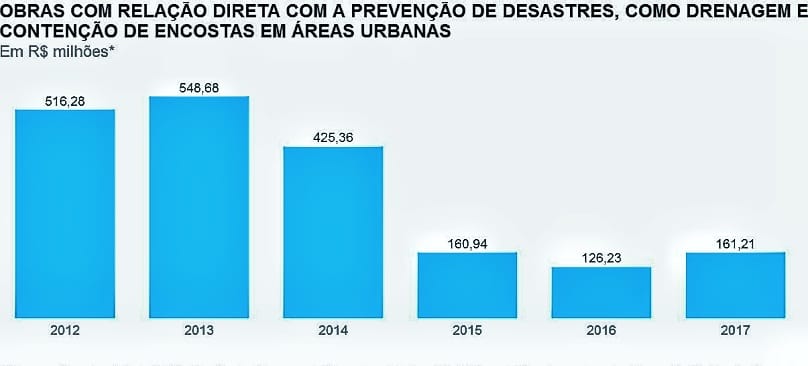Column by Henry Montalto, Contributing Reporter
RIO DE JANEIRO, BRAZIL – Avenida Niemeyer, a major artery connecting Rio’s upscale Leblon and São Conrado neighborhoods, as well as being the sole access to the Vidigal favela community, has been closed for more than a week. Now the only viable route is a set of already damaged tunnels connecting Gávea and São Conrado.
In Gávea and Leblon, residents complain of heavy traffic and hours of congestion, making a commute feel unbearable. Moreover, residents of Vidigal and those who use Niemeyer are feeling forgotten; the worry is far greater for them.

On Friday, May 31st, a Rio de Janeiro court ordered the seaside avenue closed indefinitely because one of the six locations where the hillside has collapsed is still unstable. This is due to ongoing sewer leakage and water runoff from illegal home construction.
Several families from the higher part of Vidigal have been relocated since the landslide occurred. Environmentalist Mario Moscatelli, who predicted the dangers of the Muzema tragedy before they occurred, agrees with the relocation and closing of Av. Niemeyer.
Talking with residents who live on the Vidigal hillside, however, gives a different picture — they say they’re overwhelmed and concerned about the indefinite closure of Av. Niemeyer. A resident of Vidigal, who has three school-age kids, complains about the lack of action by the state government.
Closing Niemeyer without a plan doesn’t work for her: her kids go to school in Ipanema. School transportation now costs another R$12 per school day, or “R$240 per month.” Nobody can continue doing this, she said. She may even need to keep her eldest child home while waiting for a solution.

Most students have a special transportation card; unfortunately, the card isn’t accepted by all the transport vans that go to Vidigal. Most students have always relied on public buses, but now, they can’t come by anymore as a result of the closure. It’s either walk kilometers, ride a bike or pay extra — one more inconvenience piled onto many others.
Residents of Vidigal created a petition with thousands of signatures for a free Micro-Bus from the favela to the Leblon Metrô station. Partners of Vidigal (Parceiros do Vidigal) began the petition after seeing residents and kids suffering.
Within a day, 2,000 residents signed by hand, and by mid-week over 6,000 had joined. The action was so popular it expanded online and even received an official response from the Municipal Transport Secretariat (SMTR).
Unfortunately, the response was not what the residents wanted to see. The SMTR said they are studying all possible ways to assist the residents but that a free transfer was not possible. There are more than 100,000 people affected by this closure; such a vague response just feels unacceptable.
Niemeyer’s closing affects more than 15 regular bus and van lines, with many daily commuters. Looking at the work being done by the Rio Traffic and Engineering Department (CET), it’s going extremely slowly. On most days the work is minimal or non-existent. It’s been found that some workers are on the job only one to three times a week.
When a major avenue is closed there must be immediate action. Due to the ongoing squabbles between Governor Witzel and Mayor Crivella, the situation only worsens. The infighting and politics are holding this city and its residents hostage.
In times of a significant environmental crisis in Rio de Janeiro, the city’s government has cut its natural disaster fund down to nothing. Consequently, this is what has led to the increase of historic mudslides and flooding around the city.

A resident of Rocinha said: “Not even the rains of 1966 and the 1990s had this effect; I never saw it this bad.” It’s very common for Rio to get heavy rain; what’s uncommon is the amount of damage and destruction.
In 2011 the mudslides that killed 900 people were, theoretically, going to bring about a change in the way Brazil goes about disaster prevention. The Dilma government promised R$15 (US$3.75) billion in disaster prevention funding. But by 2016, adjusted for inflation, only 33 percent of the R$15 billion had been distributed.
During the economic crisis of 2016, Rio abandoned many public works. Most of those works were preventive and/or improvements. This failure to maintain public works is the main factor leading to the city’s infrastructure being unable to handle the rains.
The Rio government reduced its environmental prevention budget by 93 percent — from R$400 million in 2013 to almost nothing three years later. A fund holding only R$75 million since 2016 has put the city in grave danger. Continuing this lack of prevention will only make the situation worse.

Furthermore, over the last ten years, only R$1.9 billion has been spent on mudslide prevention and drainage in Rio’s favelas. This has led to a massive increase in pollution and leaks, colloquially known as “black tongues” spewing raw sewage onto formerly pristine beaches.
With Av. Niemeyer closed and a state still in crisis mode, the corrective hillside and roadside work there must be expedited. It’s of utmost importance that the work continues daily and with urgency, as Rio’s South Zone is still lacking a vital road transportation link to the West of the city.

